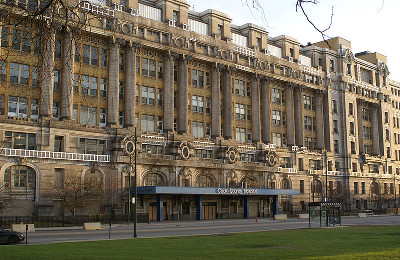
Photo by Jeff Dahl, 2008. License: CC By-SA 4.0. https://commons.wikimedia.org/wiki/File: Cook_County_Hospital.jpg
Chicagoans live at the crossroads of America. As an urban center, the city has drawn people from all over the Midwest, the country, and the world. It is a city of many firsts in national LGBTQ history.[1] The city has a long history of people who experienced same-sex desire and gender transgression who lived—and live—all over the city, from Bronzeville to Boystown, and in neighborhoods within what grew to 234 square miles. This is a story of everyday people making their lives: fighting discrimination and homophobia, coming together for pleasure and protest, and creating communities. These are sites of resistance, pain, celebration, community building, or all of the above. This chapter is not encyclopedic, but offers assistance in the issues involved when thinking about completing a nomination for a Chicago-based historic site, as well as highlighting places important in the LGBTQ history of the Windy City. Read more » [PDF 2.0 MB]
[1] Chicago was the site of the first group advocating for homosexual rights in America. Henry Gerber founded the Society for Human Rights in 1924. His home was designated a National Historic Landmark on June 19, 2015. Jonathan Farr, et al., Draft National Historic Landmark Nomination: Henry Gerber House. University of Michigan Public History Initiative, 2014. On file, National Park Service, Washington, DC. In addition, Dr. James Kiernan delivered the first-ever lecture on homosexuality in the United States (titled “Perverted Sexual Instinct”) on January 7, 1884, at a meeting of the Chicago Medical Society. Minute book of the Chicago Medical Society, 1884, Gift of the Chicago Medical Society, Chicago History Museum, 1913.0091. Also, Margaret Anderson started the famous literary periodical Little Review in Chicago in 1914. In 1915, she wrote, “Mrs. Ellis’s Failure,” which is considered the first essay arguing for homosexual rights in the United States. Margaret Anderson, “Mrs. Ellis’s Failure,” Little Review 2:1 (1915), 16-19.
The views and conclusions contained in the essays are those of the authors and should not be interpreted as representing the opinions or policies of the U.S. Government. Mention of trade names or commercial products does not constitute their endorsement by the U.S. Government.
Part of a series of articles titled LGBTQ America: A Theme Study of Lesbian, Gay, Bisexual, Transgender, and Queer History.
Last updated: August 11, 2017
